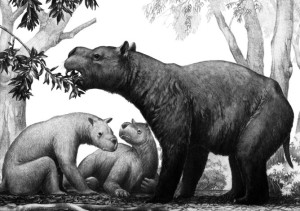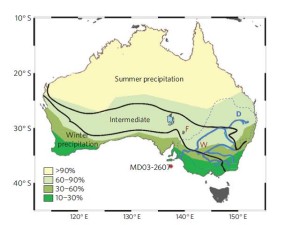Australia provides an outstanding case study to resolve the relationship between Late Quaternary environmental drivers such as climate variability, vegetation changes, wildfires, faunal extinctions and human activities. The interval between 50,000-40,000 years BP is critical for understanding the interplay of some of these factors and how they transformed the Australian landscape. During this period, humans arrived and spread throughout most the continent. At the same time, a diverse range of large browsing mammals, reptiles and birds became extinct; and there is evidence for a marked vegetation change, including more intense and frequent wildfires. Despite this paleo-environmental information, the lack of well dated environmental records has prevented scientists from resolving the relationships between these events.
Tim Flannery was probably the first to propose a causal relationship between the disappearance of great browsing mammals and the increase in fires (1). He suggested the disappearance of the big herbivores was caused by over-hunting, which triggered a massive change in the distribution and structure of plant communities that favoured wildfires, and the extinction of several other smaller animal species. Two recent high-resolution vegetation reconstructions have addressed this hypothesis, providing more detail and support for this theory.
Published last year, a radiocarbon-dated pollen and charcoal profile from northern Australia used changes of the abundance of the fungus spore Sporormiella – a genus of fungi that grows in herbivores dung – as a proxy for large browsing animal activity (2). Between 43,000-38,000 yr BP a succession of environmental changes started with a rapid decline of Sporormiella, followed by an increase in charcoal accumulation and subsequently followed by a decline of rainforest pollen taxa at the expense of grasses and Sclerophyll shrub species. Critically, fire and vegetation changes lagged behind the decline of browsing activity, suggesting that neither of these factors was directly responsible for the faunal extinction. Based on these results, the authors further suggest that the decline in herbivory led to a build up of burnable light fuels and resulted in the increase in wildfires.
A more recent environmental reconstruction from a marine sediment core offshore of southern Australia uses novel proxies for regional vegetation and wildfires over the last 130,000 years (3). Based on biochemical changes in lipids derived from leaf waxes, the regional abundance of C3 and C4 plants is inferred. These two groups of plants have different metabolisms reflecting their preferential distribution over the southern (cold climate with winter precipitation) and northern (warm climate with summer precipitation) parts of the continent respectively. Additionally, paleo-fire activity is inferred from the changes in the accumulation of a biomarker formed during burning and transported offshore by dust and smoke. The record shows how warming periods such as the onset of the present and last interglacial periods are associated with increases in C4 plants, while cooling events such as Last Glacial Maximum are associated with increased C3 plants. However, the most prominent drop in C4 plants between 44,000-42,000 yr BP does not match any climate event. This drastic vegetation transformation is accompanied by high fire activity and occurs right after the interval of disappearance of mega fauna. Similarly, the authors argue for a large-scale ecological transformation caused by the disappearance of large browsers.
These two recent articles provide evidence to support a notable ecosystem rearrangement occurring only after faunal extinction, and not the opposite way around. The implication of this is that hunting was probably the main, if not the only, driver responsible for this extinction process. The disappearance of large herbivores may have promoted the accumulation of fire-prone vegetation, permitting the occurrence and spread of human-lit fires. Further support for a leading role of hunting in the Australian late Quaternary mega fauna extinction come from the fact that other processes of faunal disappearance in the Americas (between 15,000-10,000 yr BP) and New Zealand (750 yr BP) occur coincidently with human colonization of these regions.
1. T. F. Flannery, Archaeology in Oceania 25, 45 (1990).
2. S. Rule et al., Science 335, 1483 (March 23, 2012, 2012).
3. R. A. Lopes dos Santos et al., Nature Geosci 6, 627 (2013).
Relative abundance of C4 plant and seasonal precipitation regimes in the Australian Continent. A prominent decreased in C4 plant between 44,000-42,000 yr BP is preceded by the Late Quaternary mega fauna extinction period (49,000-44,000 yr BP). Figure taken from reference Lopes dos Santos et al. (2013).

Some Australian mega fauna browsers such as the Diprotodon (in the picture) may have weighed up to several tonnes. Image courtesy of the South Australian Museum
